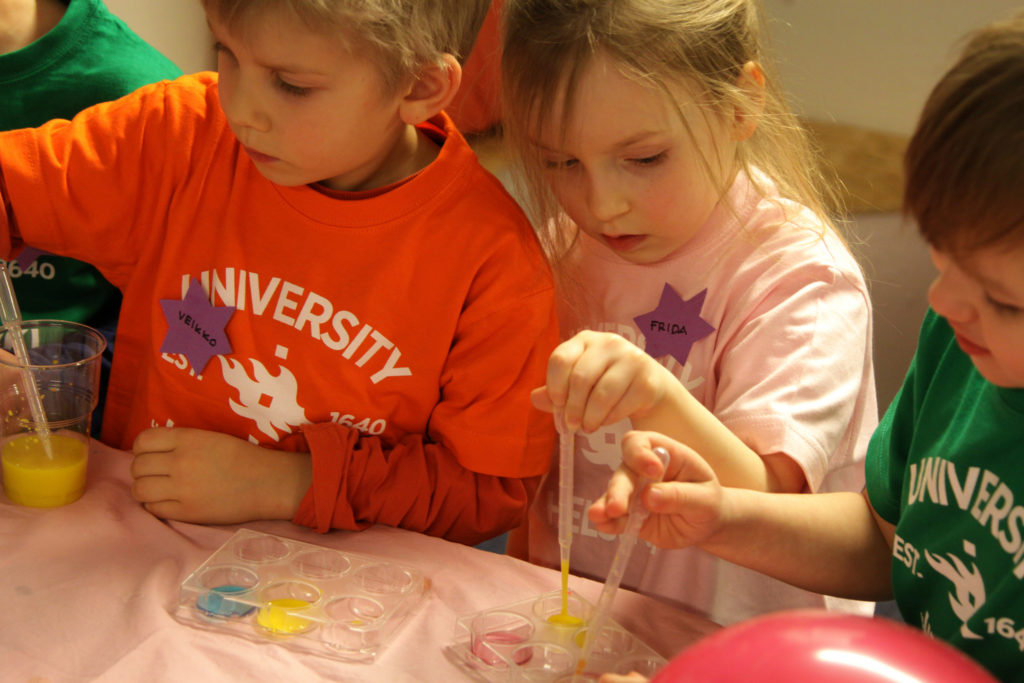In spring 2013 the LUMA Centre launched a novel science club model for 3 to 6-year old children. Project coordinator Jenni Vartiainen gives her insights on the design-based research project.
Curiosity towards our surroundings is something we recognize as a deeply human characteristic.
This ability to wonder is linked to our ability and willingness to learn new things. Small children especially display candid interest in everyday phenomena. For adults these phenomena have long since lost their novelty, but upon reflection they may reveal fundamental matters about the world and nature. By encouraging children’s curiosity educators can support and nourish their awareness of natural phenomena and even spark further interest in science.
First steps into STEM
Researchers at Finland’s Science Education Centre LUMA have explored ways of supporting the curiosity and interest of young children. Project coordinator Jenni Vartiainen used design-based research to develop a science club model for 3 to 6 year-olds.
The club model draws on the principles of socio-emotional learning to construct informal and inspiring STEM learning environments for young children. “Design research is an excellent way to develop a completely new approach. It is a great tool for analyzing the achievement of set goals and for redefining aims and research questions in further development cycles,” Vartiainen describes her method.
How to engage young children and their families in science?
The first clubs were organized as a pilot project in spring 2013 in Helsinki for 25 children in total. The club meetings were held for two age groups, 3 to 4 year-olds and 5 to 6 year-olds.
A similar structure was used for the club meetings in both age groups consisting of three stages: motivation, inquiry and sum up. In each meeting a different theme was explored, for example colors, density, space and dimensions and states of matter. In addition to the scientific themes and activities the club sessions were built on the development of social and emotional skills and motivation through art, narratives, music, drama and play. Repeated elements such as familiar songs were employed to emphasize a sense of security and familiarity in the children.
According to Vartiainen successful engagement in STEM begins with promoting a child’s natural ability to wonder and explore their surroundings.
“In my opinion it is crucial to familiarize children with the role of natural sciences and mathematics in their daily lives and to help them connect everyday phenomena to science and technology,” she says and continues to explain how “Long-term engagement cannot be sparked with cheap tricks. Children should be given a chance to wonder and ponder on something that interests them and, with the guidance of an adult, to realize their own solution. Interest and motivation in children is often awakened by exploring together the diverse ways in which natural sciences, technology and mathematics affect our lives.”
The club model encourages parental involvement and the participation of families. Vartiainen gives an example of how families participate: “After each club session the children are given an activity or excercise to be completed at home together with the rest of the family. The homework includes for example mathematics puzzles and simple practical experiments with household equipment. Parent can help the children record their answers, solutions and questions, which are discussed together at the next club meeting.”
According to feedback from the participants in the pilot clubs the model had successfully achieved its goals of increasing enthusiasm and curiosity towards natural sciences and supporting the development of personal thinking skills as well as social skills.
“The science clubs have been very important for the children: every club meeting is eagerly awaited and the children want to continue with the experiments at home. The dramatization of guide roles and the narrative framework have been successful in helping the children immerse themselves in inquiries and experiments,” says Vartiainen.
Vartiainen’s current research focuses on analyzing the questions children asked during club discussions and in developing new concepts based on the pilot club model.
“Our next plan is to launch virtual science clubs to increase the number of children involved in this kind of informal STEM education. Virtual clubs have the advantage of wider availability as participation becomes possible for children living further away,” Vartiainen reveals about future plans.
Next steps: virtual clubs to offer possibilities for all
Vartiainen sums up that there is a growing need for science clubs for young children. “Currently we need to solve the challenge of spreading and sharing the club model. The number of willing participants far exceeds our capacity and sadly we are not able to offer a club spot for all. This is an indication that despite the demand there are limited opportunities for science hobbies at a young age,” she says.
For Vartiainen, the best feedback comes directly from the responses of the young club participants: “Every time it moves me to see how fascinated the children are when they understand what they are doing and find a solution to the task at hand. The best reward is to witness how young eyes are lit by the excitement of discovery: “I understood, I figured this out, I could do this!”
Text: Maija Pollari. Photo: Elisa Lautala.


